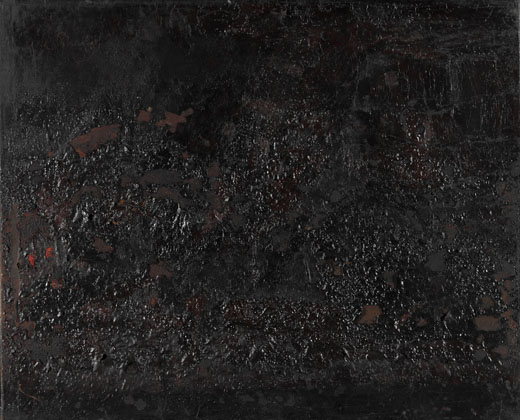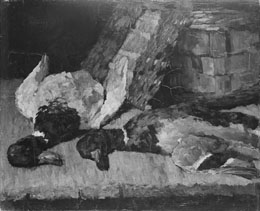
Niedersächsischen Landesmuseum Hannover
May 8 – September 6, 2015

 When does an artwork become so compromised by damage or deterioration beyond the power of conservators to restore that it loses its artwork character? Can such a damaged thing acquire non-art aesthetic characteristics that compensate, in some sense, for the losses of those aesthetic characteristics it had as an artwork? These are but two of the questions immediately prompted by an extraordinary exhibition in Hanover comprising European paintings that were damaged to varying extents by fire during an air raid on the night of October 8–9, 1943. But other, more sinister, considerations emerge on further perusal.
When does an artwork become so compromised by damage or deterioration beyond the power of conservators to restore that it loses its artwork character? Can such a damaged thing acquire non-art aesthetic characteristics that compensate, in some sense, for the losses of those aesthetic characteristics it had as an artwork? These are but two of the questions immediately prompted by an extraordinary exhibition in Hanover comprising European paintings that were damaged to varying extents by fire during an air raid on the night of October 8–9, 1943. But other, more sinister, considerations emerge on further perusal.
First, let us consider some of what is to be seen. Some of the paintings have been recuperated to a considerable extent, including a large canvas painted in 1902 by Max Slevogt that stands in the center of the gallery, a portrait of a Württemberg dragoon officer on horseback. Others present insurmountable challenges to conservators, as well as to viewers seeking to identify a subject. Among them is a Still Life with Wild Ducks (1885) by Carl Schuch. This painting is now no more than black, cracked and blistered paint crusts. Yet this canvas unquestionably has an aesthetic character, albeit inadvertent, the direct consequence of its near destruction.

The presentation of this and other badly damaged works in a setting that uses the art museum apparatus of display, invites viewers to attend to the current aesthetic qualities of the paintings. In addition, many viewers will bring aesthetically validating memories of artworks by later artists, such as Alberto Burri, who deliberately employed the destructive capacity of fire in their works. Such associations can only encourage and enhance an aesthetic response to these damaged remnants. Yet the curator responsible, Claudia Andratschke, has not presented these things unequivocally as objects of aesthetic contemplation—that they are this is an unintended irony—but rather as witnesses to the destruction wrought by a pitiless aerial bombardment.
The late W.S. Sebald analyzed Germans’ reluctance to address the consequences for their country and for themselves of the Allied bombing campaign in his great essay, On the Natural History of Destruction (1999). This exhibition is further evidence that the amnesia that so bewildered and angered Sebald, while slowly receding, still retains its power. This vestigial power lingers in the sobriety of tone of the labels and text panels in the exhibition, and of the accompanying publication. The firsthand evidence presented is chilling but discreet. Typed letters from the archives on view seek and convey conservation advice following the raid. These are letters of a kind to be found in many art museum archives, but, unlike those from other times and places, each of these concludes with a signature following the closing words, “Heil Hitler!”
Andratschke addresses not only the immediate circumstances of the fire that destroyed and damaged so many artworks, but the climate of fear, hatred, and power abuse in which this occurred. Equaling the shock of seeing so many artworks damaged beyond repair is that of the story of the administration responsible for them. The art historian, Ferdinand Stuttmann, a Nazi party member since 1933, assumed the leadership simultaneously of the major Hanover museums following the flight to the United States in 1937 of the suspended director of the Landesmuseum, and the near simultaneous dismissal of the director of the municipal Kestner-Museum, whose wife was Jewish. Having consolidated his power, Stuttmann arranged for the receipt of artworks confiscated from Hanover’s Jewish community. The exhibition includes works acquired by Stuttmann from the confiscated property of Gustav and Elsbeth Rüdenberg, who were among the many Jews deported from Hanover to Riga, Latvia in December 1941, and who subsequently perished in the Nazi genocide. The unrecognizable Schuch still life, mentioned above, was theirs, as was the relatively well-preserved canvas, Die Nacktheit (reclining female nude), by Lovis Corinth (1908). The Rüdenbergs’s heirs may have been financially compensated after the war so that their eleven surviving, fire-damaged, paintings might remain the property of the City of Hanover, but—perhaps inexplicably to contemporary museum visitors—Stuttmann, rehabilitated following denazification, became director of the Landesmuseum again in 1952, retaining the post until his retirement in 1962.
Above all, though, it is the blackened ghosts that are the artworks, through their pathos and inadvertent aesthetic power, which implicate both perpetrators and victims in shameful acts. No one comes out of this well, except perhaps the victims of the victims—the Rüdenbergs and their ilk. This important and disturbing exhibition shows us that only now is the amnesia of which Sebald wrote with such sorrowful anger beginning to recede in the discursive field of the museum, a full seventy years after the end of the war.
Ivan Gaskell is professor and head of the Focus Project at the Bard Graduate Center in New York City.
